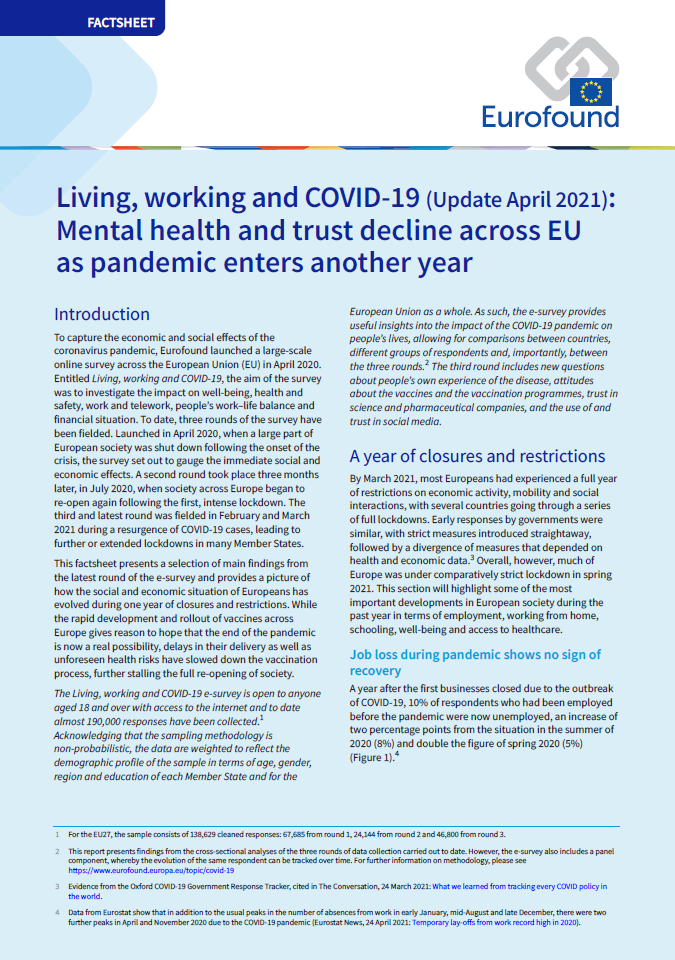The third round of Eurofound's e-survey, fielded in February and March 2021, sheds light on the social and economic situation of people across Europe following nearly a full year of living with COVID-19 restrictions. This report analyses the main findings and tracks ongoing developments and trends across the 27 EU Member States since the survey was first launched in April 2020. It pinpoints issues that have surfaced over the course of the pandemic, such as increased job insecurity due to the threat of job loss, decline in mental well-being levels, erosion of recent gains in gender equality, fall in trust levels vis-à-vis institutions, deterioration of work–life balance and growth of vaccine hesitancy. The results of the survey highlight the need for a holistic approach to support all the groups hit hard by the crisis in order to prevent them from falling further behind.
Key findings
- Mental well-being has reached its lowest level across all age groups since the onset of the pandemic over a year ago. This is especially prominent among young people and those who have lost their job.
- Existing inequalities are widening because of the disproportionate impact of the pandemic on vulnerable groups. The findings show that difficulties in making ends meet increased significantly among those already in a precarious situation.
- Citizens’ satisfaction with crisis support measures has declined dramatically, with only 12% now feeling support measures are fair, down from 22% in summer 2020. Those who felt obtaining support was easy and efficient also fell from 16% in summer 2020 to 10% in spring 2021. Close to one in ten respondents have had a request for financial support rejected.
- Trust in institutions has plummeted, especially trust in national governments which fell from 4.6 in summer 2020 to 3.9 in spring 2021. Trust in national governments across all Member States sank below levels recorded at the start of the pandemic. Trust in the EU also fell but remains higher than trust in national governments.
- Over a quarter of people living in Europe indicate a hesitancy toward the COVID-19 vaccine, with men revealing themselves more hesitant (29%) than women (25%). Vaccine hesitancy is also associated strongly with low levels of trust and social media use, with countries that register low levels of trust in government registering higher levels of vaccine hesitancy.
The report contains the following lists of tables and figures. The corresponding data for the tables and figures is available as an Excel download (328KB .xlsx).
List of tables
- Table 1: Location of work and average hours worked during the pandemic, EU27 (%)
- Table 2: Proportion of parents declaring they are too tired after work to do household jobs, EU27 (%)
- Table 3: Proportion of respondents reporting having negative feelings by age and gender, EU27 (%)
- Table 4: Request for support by employment status, EU27 (%)
- Table 5: Proportion of financially fragile respondents by employment status, EU27 (%)
- Table 6: Proportion of respondents reporting difficulties making ends meet by employment status, EU27 (%)
- Table 7: Proportion of respondents reporting arrears by group, EU27 (%)
- Table 8: Trust in the EU by sociodemographic group (mean scores), EU27 (%)
- Table 9: Trust in the national government and the EU by financial support (mean scores), EU27 (%)
List of figures
- Figure 1: Respondents who lost their job (of those who were employed before the pandemic) by country, EU27 (%)
- Figure 2: Preference to work from home post-pandemic, EU27 (%)
- Figure 3: Proportion of parents declaring they would like more online schooling for their children, even when the pandemic is over, EU27 (%)
- Figure 4: Risk of depression by age group and survey round, EU27 (%)
- Figure 5: Unmet need for healthcare during the pandemic by country, EU27 (%)
- Figure 6: Unmet need for healthcare by type of healthcare, spring 2021, EU27 (%)
- Figure 7: Requests for different types of support measures, summer 2020 and spring 2021, EU27 (%)
- Figure 8: Views about pandemic support measures, summer 2020 and spring 2021, EU27 (%)
- Figure 9: Views about pandemic support measures by country, spring 2021, EU27 (%)
- Figure 10: Proportion of respondents reporting difficulties making ends meet by country, EU27 (%)
- Figure 11: Pessimism about financial situation by economic situation, EU27 (%)
- Figure 12: Proportion of respondents stating that their financial situation will get worse, EU27 (%)
- Figure 13: Trust in institutions (mean scores), EU27 (%)
- Figure 14: Trust in the EU by country (mean scores), EU27 (%)
- Figure 15: Trust in national governments by country and survey round, EU27 (%)
- Figure 16: Stated intention to take vaccine by country, EU27 (%)
- Figure 17: Sociodemographic characteristics of people with vaccine hesitancy in Europe, EU27 (%)
- Figure 18: Reasons for vaccine hesitancy, EU27 (%)
- Figure 19: Trust in institutions among people who are vaccine hesitant and non-hesitant, EU27 (%)
- Figure 20: Vaccination hesitancy before and after 11 March 2021, EU27 (%)
- Number of pages
-
21
- Reference nº
-
EF21064
- ISBN
-
978-92-897-1700-7
- Catalogue nº
-
TJ-02-21-636-EN-N
- DOI
-
10.2806/76802
- Permalink
- Infographic: Living, working and COVID-19
Cite this publication
Eurofound (2021), Living, working and COVID-19 (Update April 2021): Mental health and trust decline across EU as pandemic enters another year, Publications Office of the European Union, Luxembourg.

